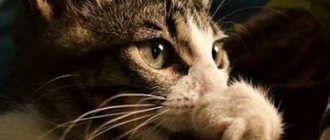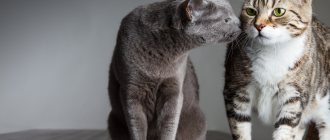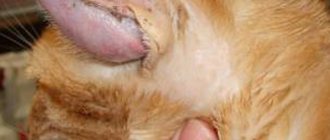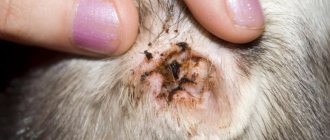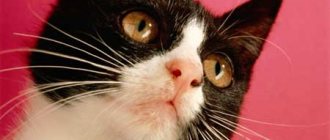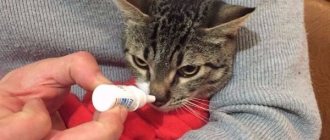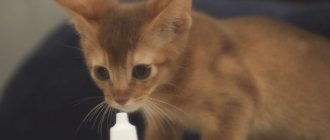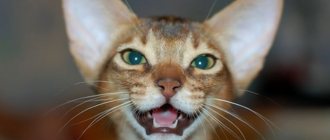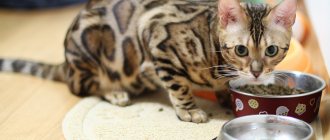Cause of runny nose
Sneezing and discharge in an animal can be caused by infectious and non-infectious causes.
Depending on this, you need to build treatment. Cats have a very high immunity, and colds - so frequent and even commonplace for humans - are rather an exception to the rule for an animal. Colds and runny noses are more common in homeless cats during periods of cold and rain. Colds occur for several reasons:
- The room is too damp, drafty.
- High humidity.
- Lack of vitamins, poor nutrition.
- Sudden temperature changes.
- The animal is hypothermic or wet (this can happen if the cat, for example, is not dried well after bathing).
Symptoms that will indicate a cold:
- Dry or, conversely, hot nose.
- Hair loss or dullness.
- Great lethargy.
- The cat sleeps for a long time or gets very scared of something that didn’t bother her before.
- Weakness (the animal stands well on its feet, but is apathetic), increased fatigue.
- Decreased appetite.
With a cold, breathing becomes difficult, the snot is clear and not viscous. The cat sneezes and coughs heavily, and the eyes may water. If discharge sticks to the muzzle or crusts appear, this means that the disease is becoming serious and may progress to the pathological stage.
Allergy
If the animal sneezes, tries to constantly rub its eyes and nose, and discharge of a transparent texture appears from the eyes, most likely, we are talking about an allergic rhinitis. The snot in this case is liquid, transparent in color (odorless), and may be accompanied by swelling and dermatitis. Breathing is impaired and itching is likely.
REFERENCE
Cats can develop allergies to a certain product. After consultation with a veterinarian and tests, he will have to be ruled out. There may be allergies to medications, pollen, house plants, and even household items. Most often, the animal reacts to the irritant after several hours, but symptoms can appear several days after encountering the allergen.
Fungi and bacteria
Human ARVI, most often, is not transmitted to cats, but if the disease is caused by certain fungi and bacteria, then both the owner and the pet can become infected with a runny nose.
A bacterial infection is indicated by:
- unpleasant smell of discharge and its yellow-green color;
- accumulation of pus in the corners of the eyes or over the entire surface;
- snot from the nose and tears from the eyes;
- constant sneezing and coughing;
- the animal constantly swallows, this is due to the fact that mucus accumulates in the nasopharynx;
- body temperature rises;
- loss of appetite;
- dehydration;
- prolapse of the third eyelid.
Fungal infections overwhelm animals with weak immunity and often the runny nose becomes chronic. An indicator of a bacterial infection is a crust in the nose, which makes breathing very difficult and snot comes out of the nose.
Foreign bodies
Coughing and sneezing may be caused by a cat swallowing a foreign object in its intestines or esophagus. If this happens, the symptoms will be as follows:
- Profuse salivation.
- If a foreign body is in the throat, then coughing and wheezing appear, the tongue turns blue, and the cat may lose consciousness.
- Constant swallowing.
- Vomiting and belching.
- Complete lack of appetite.
- Bloating.
- Lethargy, apathy, drowsiness.
- Diarrhea, constipation.
- Symptoms of general intoxication.
A runny nose can result from birth defects and injuries. For example, a “cleft palate,” that is, disturbances in the structure of the upper jaw and nasal bones, will cause the cat difficulty breathing and wheezing. Injuries to the jaw or head can result in a cleft palate. The bones can become displaced, and all this together will give the animal a chronic runny nose.
With such pathologies, the discharge does not have an unpleasant odor and most often does not affect the general condition of the cat (if the injury is cured and is not life-threatening). To clarify the causes of chronic runny nose, you should contact your veterinarian. He will identify the pathology and tell you whether it is possible to treat it or eliminate the symptoms.
A runny nose can be an indicator of inflammation that occurs in the nasopharynx or ears. And it will not go away until the initial inflammation is removed.
Why do cats get ear infections?
- Infections.
- Hypothermia.
- Other specific diseases.
Why gums and teeth can become inflamed:
- Malocclusion.
- Lack of vitamins.
- Caries.
- Tartar.
- Injury.
- Irradiation.
- Virus.
- Chemical poisoning.
With inflammation, the following clinical picture is observed:
- breathing quickens;
- discharge from the eyes becomes watery;
- the animal periodically breathes through its mouth;
- sneezing occurs infrequently;
- purulent snot, gray-green, whitish, yellow, sometimes even with traces of blood;
- loss of appetite.
Other problems that cause coughing, sneezing and sniffles include:
- Parasites, for example, worms.
- Tumor of the nasopharynx.
- Neoplasms.
- Chronic diseases.
- Infections.
- Stress.
Allergies can be the second reason why a cat has a runny nose. When an animal comes into contact with an allergen, the nasal passages narrow due to swelling, and it becomes difficult for him to breathe. If your cat has an allergic runny nose and you don’t know what exactly the cat is allergic to, you should consult a doctor. If you know, then it will be enough to remove the cause of the allergy, give the cat the usual allergy medicine and put drops into the nose for a runny nose.
A foreign body in the nose or an animal swallowed it is one of the atypical but common causes of a runny nose. The body tries to remove the interfering object by secreting mucus. Symptoms: excessive salivation, possible coughing, vomiting, digestive problems, the cat will always try to swallow. Basically, everything goes away on its own, but if the object is too large and the nasopharynx is already clogged and swollen, you need to consult a doctor.
Bacteria and fungal bodies can cause runny nose in cats. They live in every organism and can be harmless or dangerous. There are several stages of infection: if the infection is mild, your cat will experience slight discomfort, and the discharge will be clear and intermittent. In the acute stage, the discharge will be thick, it can flow without interruption, clog the animal’s nose and form crusts on it.
Infectious diseases such as calcivirosis, rhinotracheitis, chlamydia and others will manifest themselves in the first stage as a runny nose and malaise. The difference is in the degree of severity and in the fact that the discharge in this case will be more painful and may be accompanied by fever or diarrhea. Green or yellowish discharge from the nose is a reason for you to think about it.
Chronic diseases, such as diabetes or diseases of internal organs, can cause chronic runny nose in cats. The solution is a trip to the vet.
Sometimes, the causative agent of a runny nose can be acrid odors or inflammation in the ear, gums and teeth, which spreads to the nose.
Also, the cause of a runny nose in a cat can be congenital diseases and deformations of the animal’s nasopharynx. You can only check this by going to the vet.
There are various causes of a runny nose in a cat. Depending on them, separate treatment is selected. For example, if a cat is coughing and sneezing due to a bacterial infection, an antiviral drug is not given, but antibiotics are used.
Colds in cats
ARVI in cats is quite common. It is accompanied by the following clinical symptoms:
- dry cough;
- rhinitis - inflammation of the nasal mucosa, accompanied by mucus secretion;
- increased body temperature;
- occasional sneezing;
- symptoms of illness - weakness, fatigue, lethargy, drowsiness, sudden loss of strength, the cat constantly sleeps, rarely moves.
Important! Unlike a bacterial infection, a cold is not accompanied by the discharge of pus. But if there is no therapy for a long time, the pathogenic microflora is gradually activated, so a complication appears in the form of infection.
High body temperature accompanies many diseases:
- conjunctivitis;
- rhinitis;
- inflammation of various sinuses;
- tracheitis, bronchitis, pneumonia;
- ARVI.
Elevated body temperature always accompanies pathological conditions. Normally it does not rise. The temperature rises to increase the body's resistance and destroy bacteria and viruses.
Typically, viral diseases are accompanied by a slightly elevated body temperature. After 3 days of illness it gradually decreases.
If the cat gets sick with a bacterial infection, the temperature rises significantly. If there is no antibacterial treatment, it does not decrease, and the animal’s condition gradually worsens.
Causes of nasal discharge
Clear discharge in an animal cannot be caused by a cold, since animals simply do not get sick from it. Your cat may have clear fluid coming from his nose due to:
- Poor nutrition. The lack of vitamins, essential microelements and nutrients leads to weakened immunity in cats. The pet needs to eat a balanced diet at the same time;
- Infections. If the immune system is weakened, the virus easily penetrates the pet’s body, undermining its health;
- Poor living conditions. High air humidity and low room temperature can trigger the disease. The most comfortable temperature for a pet is 22 ⁰ C. The animal also gets sick after hypothermia and long walks in winter or in the rain. To prevent this from happening, you need to wipe the cat with a terry towel.
Most often, animals get sick due to a virus that has entered the body. If a cat’s eyes and nose are running (eye festering), then he has definitely caught the virus.
“Feline distemper” or panleukopenia is another terrible disease of cats. The heart, respiratory system, and gastrointestinal tract are affected. The cat suffers from severe intoxication and dehydration. The disease occurs with a high temperature of up to 41 o C, yellow-green vomiting, diarrhea, conjunctivitis, and rhinitis. Animals often stand over a bowl of water, but do not drink due to severe abdominal pain.
Rhinitis can also cause congenital nasal defects. Some breeds of cats may have discharge from the nose and eyes not related to the disease, but related to the anatomy of the animal, for example, Persian extreme cats. Some parasitic diseases cause rhinitis (toxoplasmosis).
If the discharge becomes purulent, you need to use antibacterial agents.
Nasal discharge (discharge of mucus or pus from the nose) in an animal is an attempt by its body to get rid of a pathogen or allergen. Often, secretion from the nose is accompanied by sneezing, impaired nasal breathing, and the cat may open its mouth slightly to breathe. The animal often licks its nose and the area around it. The fur near the nose becomes damp. Nasal secretions may contain blood.
Green snot is a danger signal
Green snot signals the addition of bacterial microflora. It could be as follows:
- streptococci;
- staphylococci;
- Pseudomonas aeruginosa;
- pneumococci.
These are the main bacteria that cause your pet to snot. But there may be other pathogenic microorganisms. The green color is formed due to the proliferation of bacteria, the action of the immune system, which secretes lymphocytes and inflammatory mediators. The greater the immune response, the greater the swelling and exudate.
Gradually, rhinitis with green snot becomes more complicated, leading to the following diseases:
- rhinitis;
- sinusitis;
- sinusitis;
- pharyngitis;
- frontitis.
Purulent exudate can pass not only into the sinuses, but down the respiratory system. First, pharyngitis appears, which then develops into tracheitis, bronchitis and pneumonia. This condition is common, especially in cats with reduced immune reactivity.
Purulent exudate has a thick structure, so it often completely clogs the nasal passages. The pet begins to breathe heavily and snore in its sleep. In severe cases, body temperature rises.
In rare cases, the infection can travel throughout the body, causing infectious inflammation of the kidneys, bladder, and even the brain.
Attention! If antibacterial drugs are not given to the animal in a timely manner, bacteria can enter the bloodstream, causing sepsis and death without first aid.
Symptoms of cat sneezing that should alert you
If, along with sneezing, your pet’s well-being worsens, you should rush to the veterinarian and find out why the cat is constantly sneezing.
It happens that during the initial examination, the veterinarian excludes a reaction to dust and does not find a mechanical irritant. You should not treat your cat yourself, no matter whether it has a fever or not. When the possibility of an allergic reaction is excluded, you should undergo additional examination and pass all the necessary tests. Then you will know why the cat sneezes and what to do to cure it.
Leaving matters to chance can lead to serious diseases, many of which threaten human health. For example, a cat infected with toxoplasmosis can cause a miscarriage in a pregnant woman.
Prolonged sneezing, accompanied by additional debilitating symptoms, is a reason for an immediate comprehensive examination.
Warning symptoms:
- bloody discharge from the nose when sneezing;
- sudden weight loss in a cat;
- growth of ulcers on the body;
- wool stuck together in clumps;
- diarrhea;
- vomiting;
- purulent nasal discharge and lacrimation;
- attacks of fever;
- whistling when breathing;
- wheezing cough;
- aggressive attacks towards the owner;
- photophobia.
If you notice even one or two of these symptoms, rush to the vet. Timely treatment can quickly help return your pet to the bosom of the family.
How to treat a runny nose in a cat?
If allergy
In order to remove the symptoms of a runny nose, sometimes it is enough to remove the pathogen, as is the case with an allergic runny nose. If you have a cold or runny nose, you need to follow the veterinarian's instructions and give the animal all the necessary medications. It is important to keep the animal warm so that the process does not go further, and to feed it.
Typically, the doctor prescribes a course that includes:
- Antipyretics (in case of fever);
- Expectorant (for cough);
- Antibiotics (“Cefazolin”, “Neopen”);
- Vitamins and immunomodulatory agents (“Roncoleukin”, “Derinat”, “Gamavit”).
Medicines are prescribed for a period of 5 to 10 days, drops are given daily, medicines are given several times a day.
Not everyone can afford to go to a veterinary clinic or there simply isn’t one. What to do in this case?
- Sometimes, it is enough to warm the nose so that the passage clears itself. To do this, attach a bag to your nasal sinuses, into which you pour warmed sand, buckwheat or other cereals in advance.
- You can drop a drop of aloe or beet juice into each nostril, after diluting it with water. A solution of soda will help prevent dry nose.
- Rinse your nose with boric acid or zinc sulfate, according to the attached instructions.
- Saline solution injected into the nose will relieve congestion, and streptocide powder will help remove inflammation. It will also allow you to “dry” the sensitive skin inside your nose.
- From pharmaceutical drugs, you can use immunostimulating drops "Maksidin", "Anandin" and "Glazolin" (the latter - for severe forms of the runny nose). A solution of “Naphthyzin” and “Dioxidine” in a 1:1 ratio is used to rinse the nose. Drops one drop at a time into the nostril for 5-7 days.
How to tell if a cat has a stuffy nose
When a pet tries to gasp for air, this is a deviation from the norm. However, at the initial stage, other signs of disease or pathology may be completely absent.
If the owner notices that his pet is breathing incorrectly, you should look for other symptoms:
- the cat sneezes and sniffles;
- constantly rubs his face with his paws;
- becomes lethargic, apathetic;
- eats poorly or refuses food completely.
Often the problem is accompanied by the development of conjunctivitis. The animal's rectal body temperature increases.
How to diagnose the disease yourself
You can independently identify the viral nature of the disease by the following symptoms:
- a sharp deterioration in health, prolonged sleep is not typical;
- loss of appetite;
- increased body temperature;
- snoring in sleep, bad breathing;
- nasal congestion, clear or mucous exudate may flow from it;
- the eyes begin to water, often the condition is complicated by conjunctivitis;
- Due to the movement of snot along the respiratory tract, a cough occurs.
If the above symptoms are supplemented by an elevated body temperature for more than 3 days and the presence of green snot, this indicates a bacterial infection.
With allergic rhinitis and conjunctivitis, the animal constantly sneezes and coughs, and its eyes water. The condition can last for many months with constant contact with the allergen.
Important! You can only suspect a pathological process on your own, but in order to confirm it and get the right treatment, it is better to consult a doctor who will conduct instrumental and laboratory tests.
Diagnosis and treatment
Periodic snoring is normal for humans and animals. If this happens rarely, it should not be a cause for concern. But if it's a cat sniffling while breathing all the time, or even breathing with its mouth open, it should be a cause for concern. Persistent breathing problems can lead to more serious health problems. Most likely, you will need a veterinarian's consultation and treatment, because... It is difficult or even impossible to independently determine the disease. But before contacting a doctor, it is necessary to observe an animal that is sniffling and breathing heavily. To make a diagnosis, exclude various diseases and prescribe the correct treatment, the doctor will need detailed information.
The veterinarian may ask for the following information about a cat who wheezes when he breathes:
- the age of the animal and its lifestyle;
- weight and its relationship with the norm for a given breed;
- how long ago did the wheezing occur?
- Are there other sounds heard when the cat breathes?
- changes in the color of mucous membranes;
- the presence of various injuries (torso, nose, mouth, larynx);
- changes in behavior (low activity, weakness, excitability);
- other symptoms (digestive problems, vomiting, other breathing problems, cough, runny nose, sneezing).
If your cat is breathing poorly through his nose and sniffling, you should not wait for this to go away on its own. Such signs may indicate a serious illness in a cat or kitten that requires immediate treatment.
© shutterstock
By the nature of the snoring and sounds, you can often roughly determine the source of the disease:
- wet rales indicate the presence of phlegm in the respiratory organs;
- dry wheezing indicates the presence of swelling in the bronchi or throat;
- crackling – there may be problems in the alveoli;
- A whistling sound may indicate swelling in the respiratory tract.
Only a qualified specialist should diagnose and prescribe treatment for a cat that wheezes when it breathes. Independent choice of treatment method and incorrect diagnosis of the disease can lead to a significant deterioration in the animal’s condition.
Only timely initiation of treatment and the correct choice of medications can ensure a quick and complete recovery of the pet. You should not rely on the recommendations of other cat owners from forums - each case is individual, even with similar symptoms.
Useful materials:
- Cutaneous horn General description of the disease Cutaneous horn on the forehead or face (ICD 10 code - L57.0) -...
- Cloudy eye in a cat Common causes of cloudy eyes in a cat The most common causes of cloudy eyes are glaucoma, cataracts or keratitis.…
- Itching and odorless discharge Main causesBefore considering the factors that provoke the appearance of discharge that has a sour odor, it is necessary to immediately note...
- Normal temperature in animals Normal temperature in different types of animals Veterinary services Day hospital for animals Veterinary certificates Vaccination…
Prevention of runny nose in cats
You can prevent your pet from sneezing and coughing by taking a number of measures:
- Make sure that there are no drafts in the room;
- Provide your cat with a balanced diet (with vitamins and minerals);
- Make the necessary vaccinations and show the animal to the veterinarian;
- If the animal is dried with a hairdryer, then there is no need to direct the stream towards the muzzle;
- Vaccination. Including from seasonal infections and changing living conditions;
- Deworming (treatment for parasites) using special means;
- Frequent wet cleaning of the premises;
- Isolation of household chemicals from animals.
The primary task during a runny nose is to establish the true causes of the disease (to do this, contact a veterinarian) and improve breathing. The animal can recover only under the close supervision of the owner and with proper care.
- Carry out timely vaccination and deworming;
- Try to prevent your cat from catching a cold; move the bed to a warm place; after you have washed the animal, dry it with a hairdryer;
- Create a balanced diet; this, coupled with an active life, is the key to good immunity, which will allow the animal to get sick less often;
- Try to limit your animal's contact with allergens and chemicals.
Treating a cat for sneezing
Only a veterinary specialist at the clinic can prescribe the correct treatment for a cat with symptoms of sneezing. If, during a clinical examination of your cat, a veterinarian determines that your cat is clinically healthy, he will recommend that you wet clean your apartment and use a special humidifier.
If the cause of sneezing is allergic in nature, then recommendations will be given to eliminate the allergen present in the apartment or to ensure that household chemicals are inaccessible to your cat. In order to alleviate the condition, a veterinarian will prescribe one or another antihistamine to your animal.
In the case where the cause of sneezing is polyps, it will be recommended to remove them surgically in a veterinary clinic.
If a cat's sneezing is accompanied by an asthmatic attack, antispasmodics, vasoconstrictors and corticosteroids are prescribed.
In case of diseases of the oral cavity (teeth, gums), a sick cat is given dental treatment, tartar is removed (tartar in cats), inflammation of the gums is relieved, and vitamins are prescribed.
If a helminthic infestation is detected in a cat during an examination, the veterinarian will prescribe special anthelmintic drugs.
If the cause of a cat’s sneezing is an infectious disease diagnosed in the clinic’s laboratory, then the sick animal will be prescribed antibacterial and antiviral drugs and immunomodulators.
The oncological cause of sneezing in a cat is eliminated by performing surgery to remove the tumor and prescribing a course of chemotherapy.
Traditional methods of treating a runny nose
If your cat sneezes and has snot, your veterinarian will tell you what to do. It is not recommended to apply therapeutic measures on your own, as a serious illness may occur. It is better to undergo a full examination first.
Cold
If a cat has a cold, the use of antibiotics is recommended only if there are complications in the form of green snot and the spread of infection.
Otherwise, the following types of drugs are indicated:
- antipyretics for prolonged high temperatures;
- expectorant medications that help thin and release mucus;
- vitamin therapy, which improves the resistance of the immune system so that it can independently fight the disease;
- vasodilating drops for rinsing the nose, for example, Naphthyzin;
- antiviral drugs (Anandin);
- immune system stimulant (Derinat as nasal drops).
Important! The course of treatment is no more than 7 days. During this period, the cat should recover completely. If this does not happen, consult a doctor again.
Allergic rhinitis
If a cat sneezes and coughs, how to treat allergies at home, the veterinarian tells us after conducting an allergy test:
- complete elimination of the allergen from the pet’s life;
- taking antihistamines when the first signs of allergy appear (Suprastin, Zodak);
- in rare cases, when allergies are accompanied by severe dermatitis, steroid hormones are prescribed;
- immunotherapy, that is, the pet’s body is gradually saturated with the allergen in small quantities so that the immune system gets used to it.
If the allergy is accompanied by diarrheal disorders and digestive disorders, the animal is prescribed a constant diet that eliminates the introduction of any allergen.
The body can cope on its own, but to do this, you can stimulate the immune system. For example, with the drugs Derinat, Gamavit.
They give an antiviral drug, but if an antibacterial infection occurs, an additional antibiotic is prescribed (Neopen, Cefazolin, Macropen).
In order for the cat to quickly cope with a cold, do not disturb it and give it plenty of water. To help her move around less, a bowl of food can be placed next to her bed.
Complication of infection
For traditional methods of therapy, herbal decoctions are used, which can be instilled into the cat's nose or washed out of the eyes from suppuration. Suitable for this:
- chamomile;
- coltsfoot;
- calendula.
They can be brewed together or separately. They not only have anti-inflammatory and antibacterial effects, but also saturate the body with vitamins.
Important! To eliminate suppuration and pain in the eyes, you can wash them with oak bark tincture. It has tanning properties and acts as an antiseptic.
Diseases that cause sneezing and nasal discharge in cats
Let's look at the most common ailments that can cause your pet cat to sneeze frequently and have snot:
- Colds are perhaps one of the most common reasons why a cat sneezes and has snot. Like their owners, cats can catch colds as a result of contact with sick relatives, as well as due to a decrease in immunity caused by hypothermia.
- Allergic reactions . They can be caused by various substances that have a strong odor, for example, household chemicals or the perfume of the animal's owners. Sometimes the allergen can be tobacco smoke, pollen, house dust or even the fur of other animals.
- Various viral infections . The reason why a cat is periodically bothered by snot and sneezing may be an evil virus, for example, adenovirus or herpes.
- Eye infections such as conjunctivitis and keratitis can cause your cat to suffer from runny nose and sneezing.
- Entry of foreign objects into the nasopharynx. In this case, the increase in the sneezing reflex is caused by the body’s desire to free itself from an object that makes breathing difficult. Cats, like small children, are very curious, stick their noses everywhere and can accidentally inhale a piece of napkin, dust, fur or some other small object.
- Growths or polyps have formed in the nasopharynx, which interfere with the normal functioning of the respiratory system, causing the animal to sneeze frequently.
- Chronic asthma can provoke the appearance of the symptoms in question for a long time.
- Dental and gum disease can lead to snot and your pet sneezing.
- Malignant tumors and neoplasms - this reason is not very common, but this option should also be kept in mind.
- And finally, unpleasant symptoms in the form of sneezing and snot in a cat can be caused by the presence of parasites in the animal’s body, which have a depressing effect on the entire body and can cause breathing problems.
© shutterstock
As must have already become obvious to the reader, symptoms such as snot and the fact that the cat often sneezes can indicate the presence of a variety of diseases; using these signs alone, it is almost impossible to determine what your mustachioed friend is suffering from. Since among the potential ailments there are also very serious ones, it is better, as they say, not to tempt fate and immediately take the cat to a veterinary clinic, where a specialist can examine him and, possibly, take the necessary tests.
However, there are symptoms that even a person without special education can recognize.
What signs can be more or less likely to suggest which of the listed diseases is tormenting your pet and why he constantly sneezes, we will discuss in the next section.
Prevention of runny nose in cats
If your cat has non-green snot, it is recommended to adhere to the following treatment regimen:
- Apply vasoconstrictor drops to relieve swelling, inflammation and temporarily eliminate the release of exudate (Galazolin, Naphthyzin).
- Instill an antibiotic or antimicrobial agent (Dioxidin, Tobrex, Vigamox, Levofloxacin).
- Instead of antibiotics, antimicrobial solutions can be used, for example, zinc sulfate, boric acid.
Gradually the condition of the nose and sinuses returns to normal. If a cat has allergic rhinitis, it is recommended to add antihistamines and a hormonal substance to the vasodilators.
Prevention
If the cat’s sneezing is harmless and caused by the presence of dust in the apartment, then the owners will need to keep their apartment clean and regularly carry out wet cleaning of the room. If sneezing is allergic, owners must protect their pet from the allergen (air freshener, perfume, perfume, washing powder, tobacco smoke, etc.).
An effective way to prevent the infectious component of cat sneezing is to vaccinate animals according to the existing schedule. Starting from six months, you need to follow the vaccination schedule and vaccinate them against: viruses; cat flu; leukemia and leukopenia; rabies.
Oral diseases are prevented by constant monitoring of the condition of the oral cavity and teeth, and timely removal of tartar.
Worm infestations in cats are prevented by regular deworming of the animal with anthelmintics.
The main thing is to undergo regular preventive examinations of your cat at a veterinary clinic in order to detect danger in time and begin timely treatment.
Treatment
To treat your cat, it is recommended to use the treatment prescribed by your veterinarian. It is not recommended to use the following methods without his approval:
- give antibiotics without prescription;
- use herbal preparations if you have allergies;
- give drugs that are intended for people, but not animals (some drugs are only suitable for humans);
- walk your pet if it has an elevated body temperature;
- often give an antipyretic, body temperature may drop below the minimum level, which will lead to a drop in blood pressure, a sharp loss of strength, and fainting;
- give hormonal substances;
- Treat the animal yourself if only 1 of the signs of illness appears, that is, the cat could sneeze, but this does not necessarily mean the appearance of a runny nose or cold.
Many medications require veterinarian approval. If the pet owner neglects this rule, he may get complications. For example, when treating a viral disease with antibiotics, a fungal infection and disruption of the intestinal microflora may gradually develop.
Rhinitis is often complicated by conjunctivitis
Since a runny nose often becomes only an indicator of a viral infection or other inflammation in the body, it will be necessary to treat not so much it as the root cause. It is not always possible to independently find out the true source of the disease. Therefore, it is very important to consult a veterinarian, conduct a diagnosis and follow the treatment plan.
It will be very difficult to cure a stray cat from a runny nose if he is not provided with comfortable conditions: warmth, food, vitamins and scheduled medications.
Colds and rhinitis
If your cat's cold cannot be treated at home, then you need to seek help from a veterinarian. The clinic will examine the cat and prescribe the necessary medications. It is not recommended to use medications without a prescription from a specialist. Typically treatment includes:
- Taking antipyretics if the temperature persists.
- Expectorants.
- Antibiotics.
- Vitamins.
- Droppers (to avoid dehydration).
Drugs used:
- Maxidin. Drop into the nose to stimulate the immune system.
- Anandin. Antiviral and immune system stimulant.
- Naphthyzin together with Dioxidine. Nasal rinsing.
- Galazolin. Drops to ease breathing.
One drop of the drug is instilled into each nostril. The course is from five days to a week. You can rinse your nose with zinc sulfate (2%), boric acid (3%), a mixture of Methanol and fish oil.
Other means: “Maksidin”, “Derinat”.
What to do if your cat has a stuffy nose
Your veterinarian will tell you what to do with a cat with a stuffy nose. Therapeutic therapy depends on the root cause that provoked this pathology. In order not to aggravate the condition of your beloved pet or provoke serious complications, you should not self-medicate. It is necessary to treat a stuffy nose in a cat comprehensively, taking into account the main cause of the disease.
If a cat breathes through its mouth, its nose is blocked and the reason lies in the presence of a foreign object in the nasopharynx or nostrils, it must be carefully removed from the nasal passages. Entrust this procedure to your veterinarian.
If the nose is blocked, rhinitis is provoked by bacterial or viral infections, cats are prescribed complex antibacterial drugs, systemic broad-spectrum antibiotics. To eliminate this problem, the treatment was effective, the course of antibiotic therapy must be completed completely.
Animals with a stuffy nose can be prescribed sedatives, anti-inflammatory, antipyretic, and decongestant restorative drugs. To relieve inflammation of the nasal mucosa, in addition to general drug treatment, the veterinarian will prescribe special nasal drops (Dioxycycline, Naphthyzin). For a severe runny nose, drops are instilled into each nostril two to three times a day until complete recovery.
© shutterstock
In case of severe rhinitis, Fosprenil will help normalize the condition of your pet. The dosage and frequency of administration will be prescribed by the attending veterinarian.
If your pet has a stuffy nose, inhalations based on essential oils of coniferous trees and warm compresses can help. You can warm your pet’s nose with salt, sand, herbs, wrapping them in a fabric bag or clean cloth. You can rinse your nose with young aloe juice.
Systematically remove the crust from the lobe with a damp sterile cotton-gauze swab. If the mucous membrane is extremely dry, lubricate the area around the nose with baby cream, oil, or Vaseline.
During treatment, if the cat has a stuffy nose, carefully monitor the health of the pet, follow all the recommendations of the treating veterinarian
Treatment at home
What to do if the kitten can’t breathe through its nose? How to treat it correctly? Even if your pet has mild nasal congestion and other symptoms of the disease, it is necessary to establish an accurate diagnosis, and only a veterinarian can do this. The first thing to rule out is infectious diseases. They tend to develop very quickly, often after contact with other people's animals, accompanied by other symptoms. Depending on the cause, a course of treatment will be prescribed.
Course of antibiotics
How to stop a cat from tearing up furniture: reasons and what you can spray on the sofa
In case of an infectious disease, the cat is prescribed a course of antibiotics. The medication is continued until the end, otherwise the likelihood of the infection returning and the occurrence of chronic inflammation of the nasal mucosa increases. In addition, your veterinarian may also prescribe antipyretics and anti-inflammatory drugs.
Rinse and inhalation
What should you do if your cat’s nose is clogged and he grunts, and treatment progresses very slowly? To speed up the healing process, it is recommended to use rinsing, inhalation with essential oils and moisturizing the nose with baby cream.
Vasoconstrictor drops
If a cat grunts when breathing and has quite severe nasal congestion, she is prescribed drops for a runny nose - a vasoconstrictor drug with an immunostimulating effect. Typically, such medications are prescribed for a period of up to 1 week.
Important! Only drops specifically designed for cats are allowed to be instilled. It is better not to exceed the recommended dosages.
During the treatment period, the cat should drink plenty of warm water and eat only warm food. If an animal refuses to eat, you should purchase food that has a richer aroma.
Vasoconstrictor drops should be purchased only those intended for pets
Medications should be purchased taking into account the age of the animal. For example, kittens are prohibited from taking medications that are intended for adults. Even if the drug is for children, it is important to ensure that the dosage is maintained. If there is an excess of drugs in the body, the pet may begin to experience side effects.
To remove nasal discharge, use a cotton pad or swab. The procedure must be carried out with extreme care, otherwise if the mucous membrane is damaged, the condition will only worsen. If the discharge is abundant and the cat is noticeably sniffling, then the nose should be rinsed with boiled water or saline solution. In this case, you should use a pipette or syringe without a needle.
Causes of nasal congestion
If your pet is not breathing as expected, you need to figure out what caused it as quickly as possible and begin treatment.
Nasal congestion develops:
when copious secretions thicken and, drying, fill the respiratory passages;- due to swelling of the mucous membrane.
The condition of a cat's respiratory tract is influenced by many factors. Some are external in nature, others should be sought inside the body.
Causes of improper breathing in cats
| Factor | Description |
| Birth defects | Characteristic of certain breeds of cats with a shortened muzzle - Persians, British, etc. With a specific structure of the skull, a narrowing of some areas of the nasal cavity is observed. This deficiency predisposes to the development of infections. |
| Pathogens | Acute respiratory infections are also common in cats. Pets can catch a viral infection, which without appropriate treatment is complemented by a bacterial one. As a result, one disease is joined by others |
| Fungus | Spores that enter the respiratory tract lead to the development of mycoses, in which a runny nose often becomes chronic and the discharge becomes purulent and mucous. |
| Neoplasms | Oncology does not spare animals either. A tumor in the nasal cavity can be suspected by purulent, foul-smelling discharge from one nostril |
| Injuries | The pet can get damage to the mucous membrane in a fight, fall, etc. The wounds bleed, pyogenic microbes get into them |
| Oral diseases | Fistulas on the gums, abscesses of tooth roots and other dental problems provoke swelling of the mucous membrane of the nasal ducts |
| Allergies | They appear more often in purebred cats. Irritants include:
|
| Infestations | Worms often settle in the respiratory tract - they need oxygen to develop. The presence of parasites provokes not only rhinitis, but also pneumonia |
| Foreign objects | More often it manifests itself as unilateral congestion. A foreign body can injure the mucous membrane, a sign of which is bloody discharge. Prolonged presence of an object in the nasal cavity causes purulent inflammation |
| Systemic diseases | Common in elderly cats with weakened immune systems. A characteristic symptom is nosebleeds due to high blood pressure or poor blood clotting |
This problem occurs more often in kittens than in adult cats. This is due not only to the underdevelopment of the immune system.
Babies can catch the infection even during the fetal development phase - from a sick mother.
Differences from a human runny nose
Rhinitis is a disease caused by inflammatory processes affecting the mucous membranes of the nasopharyngeal sinuses.
A characteristic sign of a runny nose is copious discharge from the nostrils. They can be transparent and cloudy, colorless or yellowish-green (sometimes mixed with blood), liquid or viscous-thick.
In cats and humans, the signs of a runny nose are identical.
Rhinitis can be unilateral or bilateral, short-term or prolonged.
The main difference lies in the factors that provoked problems with the nose. If in humans the main reason lies in allergic reactions to irritants and the penetration of a viral infection into the nasopharynx, then in animals the “culprits” are more serious and dangerous.
Mr. Cat recommends: features of treating a runny nose in a kitten
A kitten's growing body requires more careful attention when dealing with a runny nose. First of all, it is necessary to improve the living conditions and nutrition of the small pet.
For a speedy recovery, you can do inhalations using eucalyptus oil: you need to add a few drops of oil to a container of hot water, then turn the kitten’s head towards it so that it can inhale the vapors, and cover it with a napkin.
Here you should be careful not to burn your pet.
The warming up procedure will also be useful. To do this, you can use bags of salt or sand.
To ease breathing, children's drops are suitable: Aqua Maris, Pinosol.
